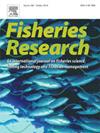减少码网尺寸和改变配置,以提高选择性在澳大利亚白拖网(西拉斯戈)
IF 2.2
2区 农林科学
Q2 FISHERIES
引用次数: 0
摘要
为了响应澳大利亚新南威尔士州(NSW)外的白鳕(Sillago flindersi和S. robusta)实施的个人可转让配额(ITQ),进行了两项实验,以调查用更小的网目设计取代法定的代码(受最小法定拉伸网目开度的限制,smo是最佳网目开度的两倍)是否可以减少拖网目标的效率和绝对副渔获量。在实验1中,与包含95 mm SMO(拉伸周长为~ 20 m,但被绳子限制在3.4 m)的传统码尾相比,由46 mm SMO在适当周长(拉伸周长为~ 11 m)制成并由94 mm SMO提升袋包围的无限制码尾捕获了~ 3-8 × 多的白鲸h-1拖网。总副渔获重量h - 1也增加了,但仅增加了~ 2 × ,因此,就绝对数量而言,捕捞小网目鱼类可以使丢弃副渔获物减少至少37 %(或~ 1800吨),减少~ 5500 小时的拖网作业,从而使新南威尔士州的拖网渔船每年平均收获~ 425吨的捕捞配额。在实验2中,用较小的41 mm SMO旋转90°的圆柱体(' T90 ')和相同的提升袋替换40 %的46-mm码端,进一步提高了漂白效率,但没有尺寸选择性,并且不影响副渔获量。研究结果表明,在将渔业转移到ITQ管理时,需要考虑对渔具进行相应的修改,以尽量减少不必要的环境影响。本文章由计算机程序翻译,如有差异,请以英文原文为准。
Reducing codend mesh size and changing configurations to improve selectivity in Australian whiting (Sillago spp.) trawls
In response to individual transferable quotas (ITQ) being implemented for whiting (Sillago flindersi and S. robusta) off New South Wales (NSW), Australia, two experiments were done to investigate if fish-trawl target inefficiencies and absolute bycatches could be reduced by replacing the legislated codend (handicapped by a minimum legal stretched mesh opening—SMO twice the optimum) with smaller-meshed designs. In experiment 1, compared to a conventional codend comprising 95 mm SMO (with a stretched circumference of ∼20 m, but restricted to 3.4 m by a rope), an unrestricted codend made from 46 mm SMO at an appropriate circumference (∼11 m stretched) and surrounded by a 94-mm SMO lifting bag caught ∼3–8 × more whiting h–1 trawled. Total bycatch weight h–1 trawled also increased, but only by ∼2 × and so, in terms of absolute amounts, fishing the smaller-meshed codend could evoke at least a 37 % reduction in discarded bycatch (or ∼1800 t) and ∼5500 h less trawling to harvest an average of ∼425 t of whiting quota each year by fish trawlers in NSW. In experiment 2, replacing 40 % of the 46-mm codend with a cylinder of smaller 41 mm SMO turned 90° (‘T90’) and with the same lifting bag further improved efficiency for whiting, but not size selectivity, and without affecting bycatch. The results illustrate the need to consider concomitant fishing-gear modifications in fisheries transferring to ITQ management to minimise unwanted environmental impacts.
求助全文
通过发布文献求助,成功后即可免费获取论文全文。
去求助
来源期刊

Fisheries Research
农林科学-渔业
CiteScore
4.50
自引率
16.70%
发文量
294
审稿时长
15 weeks
期刊介绍:
This journal provides an international forum for the publication of papers in the areas of fisheries science, fishing technology, fisheries management and relevant socio-economics. The scope covers fisheries in salt, brackish and freshwater systems, and all aspects of associated ecology, environmental aspects of fisheries, and economics. Both theoretical and practical papers are acceptable, including laboratory and field experimental studies relevant to fisheries. Papers on the conservation of exploitable living resources are welcome. Review and Viewpoint articles are also published. As the specified areas inevitably impinge on and interrelate with each other, the approach of the journal is multidisciplinary, and authors are encouraged to emphasise the relevance of their own work to that of other disciplines. The journal is intended for fisheries scientists, biological oceanographers, gear technologists, economists, managers, administrators, policy makers and legislators.
 求助内容:
求助内容: 应助结果提醒方式:
应助结果提醒方式:


